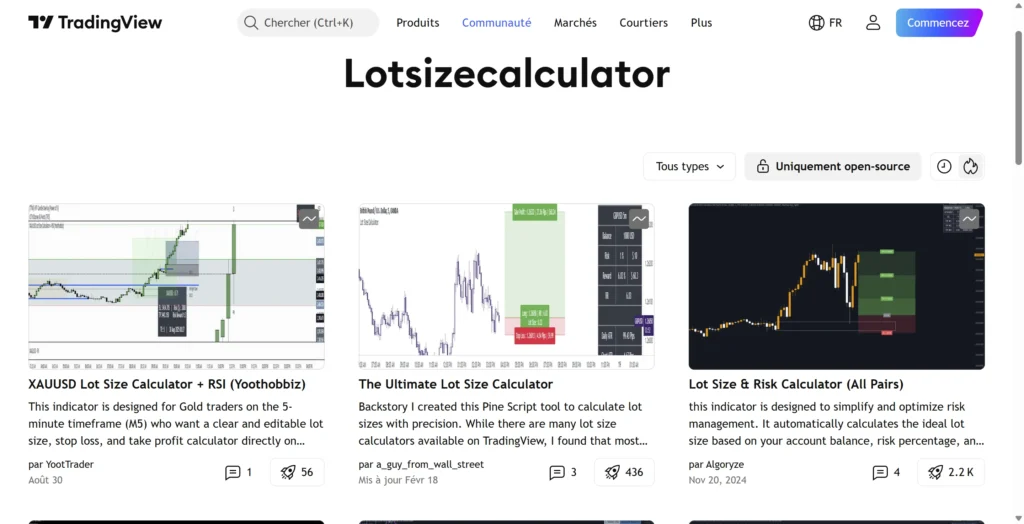Position size management is one of the pillars of the money management in trading. Knowing how to correctly calculate a lot and size your position according to your capital can make the difference between preserving your account and incurring major losses.
Money Management
What you'll learn:
Whether you trade forex, indices or commodities, understanding how to calculate a trading lot and adjust your position size is essential for protecting your capital over the long term.

There are four main types of lot, each suited to different trader profiles and capital sizes.
Standard batch (1.0) equals 100,000 units of currency. On EUR/USD, each 1 pip movement represents 10$ of gain or loss. This type of lot is suitable for traders with substantial capital, generally in excess of 10,000$.
The mini-batch (0.1) corresponds to 10,000 units of currency, or one-tenth of a standard lot. With a mini-lot on EUR/USD, each pip is worth 1. This format is suitable for traders with average capital (between 2000 & 10 000$).
The micro-batch (0.01) represents 1,000 units of currency, or one hundredth of a standard lot. Each pip is then worth 0.10$ on EUR/USD. This type of lot is ideal for beginners or small accounts (less than 2,000$).
The nano batch (0.001) equals 100 units of currency. Each pip is worth 0.01$ on EUR/USD. Some brokers offer this format for very small accounts or for testing strategies with minimal risk.
Summary table of pip values by lot type (EUR/USD) :
| Batch type | Units | Rating | Pip value |
|---|---|---|---|
| Nano batch | 100 | 0.001 | 0.01$ |
| Micro batch | 1 000 | 0.01 | 0.10$ |
| Mini lot | 10 000 | 0.1 | 1$ |
| Standard batch | 100 000 | 1.0 | 10$ |
Lot size directly determines your exposure to the market and therefore the amount you risk on each trade. It's the central element of your trading risk management.
Trading with a lot that's too big for your capital can destroy your account in just a few losing trades. Let's imagine an account of 1,000$ trading 1 standard lot on EUR/USD with a stop loss of 20 pips. A single losing position represents a loss of 200$, or 20% of capital. Three losing trades and the account is reduced by 60%.
Lot size always works in combination with your stop loss. A 50 pip stop with 0.1 lot represents 5$ of risk, while the same stop with 1 lot represents 50$. It's the combination [lot size × stop distance × pip value] that determines your real dollar risk.
Good lot size management allows you to survive the series of losses that are inevitable in trading. If you risk 2% per trade maximum, you can take 10 consecutive losses and lose only 18% of your capital. With a risk of 10% per trade, these same 10 losses would reduce your capital by more than 65%.
Calculating position size is a fundamental skill that every trader must master. This section gives you the complete method for correctly sizing your positions.
Before applying a formula, you need to know four essential elements.
Account size (available capital) This is the total amount you have in your trading account. This capital serves as the basis for all your risk calculations. If you have 5,000$ in your account, this amount determines how much you can risk per trade.
Percentage risk per trade: the 2% rule The 2% rule is a widely recognized money management standard in professional trading. It stipulates that you should never risk more than 2% of your capital on a single position. This rule protects your account from series of losses and ensures stable growth over the long term.
Why 2% specifically?
This limit allows you to absorb a long series of losses without jeopardizing your trading activity.
Comparison :
An account that loses 50% must then make +100% to return to equilibrium. This is why limiting risk is crucial.
Stop loss size (in pips) The stop loss represents the distance between your entry price and the level where you'll exit if the market goes against you. This distance must be expressed in pips. For example, if you buy EUR/USD at 1.1000 with a stop at 1.0950, your stop loss is 50 pips.
The size of your stop loss should be determined by your technical analysis (support, resistance, market structure), not by your desired position size.
Pip value by currency pair The value of a pip varies according to the pair traded and the size of the lot. For a standard lot (1.0) :
For a mini-batch (0.1), divide these values by 10. For a micro-batch (0.01), divide by 100.
Here is the simple formula to calculate your position size according to your risk:
Position size = (Capital × Risk %) / (Stop loss in pips × Pip value)
This formula gives you the position size in number of lots.
Step-by-step numerical example :
Situation: You have an account of 10,000$ and want to buy EUR/USD at 1.1000 with a stop loss at 1.0950.
Step 1: Calculate the amount to risk
Step 2: Determine stop distance in pips
Step 3: Knowing the pip value
Step 4: Apply the formula Position size = 200$ / (50 pips × 10$) Position size = 200$ / 500$ Position size = 0.4 lot
Result: You have to trade 0.4 lots (i.e. 4 mini lots or 40 micro lots).
Check: If the market hits your stop loss at 50 pips with 0.4 lot: Loss = 50 pips × 10$ × 0.4 = 200$ ✓ (well 2% of 10 000$)
Although understanding manual calculation is essential, using a batch calculator or position size calculator can save you time and avoid mistakes, especially when you're trading several pairs with different pip values.
The benefits of calculators
A position size calculator gives you the result in seconds. You enter your capital, risk, stop and traded pair, and the tool instantly calculates the optimal lot size. The calculators include up-to-date pip values for all pairs and adapt to your account currency (USD, EUR, GBP, etc.).
The majority of trading platforms (MetaTrader 4, MetaTrader 5, TradingView) integrate position calculators directly into their interface. Some specialized websites also offer free online calculators.
Even with a calculator, always check the result with a quick estimate. If your calculator tells you to trade 5 lots on a 1,000$ account, you've obviously made a mistake. It's good practice to keep a critical eye on automatic results.
At Xenesy, we teach our students to first master manual calculation before using calculators. This in-depth understanding enables us to detect inconsistencies immediately.

The result of your formula gives you a decimal number representing lots. Now you need to convert this number into a combination of lots that your platform accepts.
When your calculation gives 0.4 lot, it means :
Most modern brokers accept lot sizes to the nearest hundredth (0.01), which corresponds to the micro lot. Some even accept thousandths (0.001, nano lot).
Rounding the waist: up or down?
In rigorous money management, always round down if you have to. Your calculation of 2% of risk is a maximum not to be exceeded. If your calculation gives 0.37 lot and your platform only accepts 0.35 or 0.40, choose 0.35.
Adapting the lot to your capital
Small account (less than 1,000$) Use mainly micro lots (0.01). This allows you to trade even with a small capital and still respect the 2% rule.
Average account (1 000$ to 10 000$) Combines mini-batches (0.1) and micro-batches (0.01) according to the needs of each trade.
Large account (over 10,000$) You can use standard batches (1.0) in combination with the other batch types.
Adjust according to the pair traded
Not all pairs have the same pip value. On GBP/JPY, higher volatility often requires wider stops, which mechanically reduces your lot size for the same 2% risk.
Background :
Calculation :
Check: 50 pips × 10$ × 0.32 = 160$ ✓
Result: Trade 0.32 lot with a controlled risk of 2%.
The classic mistake: deciding on the lot size before setting the stop. Many traders choose how many lots they want to trade, then place their stop accordingly. This approach reverses the logic of money management.
The right approach:
Your stop loss should be determined by the market, not by your desire to trade a certain size.
"I risk 5-10% per trade to win faster" - this is the most destructive mistake.
Example with an account of 10 000$ :
Risk of 10% per trade :
Risk of 2% per trade :
The 2% rule is not arbitrary; it's a mathematical protection against ruin.
I always trade 0.1 lot, it's simple" - this approach creates two problems:
Variable risk :
Your risk varies enormously, making your management inconsistent.
Non-adaptation to capital : Your capital evolves. If you always trade the same size, when your capital increases, you risk proportionally less (too conservative). When it decreases, you risk proportionally more (too aggressive).
Best practice: Recalculate your lot size for EACH trade according to your current capital, specific stop and 2% fixed risk.
After managing hundreds of positions, here's how I refined my calculation method and the lessons I learned.
Key points of my experience
At first, I calculated my lots by hand for each trade. This step enabled me to really understand the mechanics and immediately detect any inconsistencies. Today, I use a calculator integrated into MT4/5, but I still mentally check that the result is consistent.
My personal rule: I never exceed 1.5% of risk per trade, even though the standard rule is 2%. This extra margin of safety has enabled me to get through several series of losses without undue stress.
The mistake I made
At the start of my career, I traded for months with a fixed lot size of 0.1, without adjusting my stops. As a result, some trades risked 0.5%, others 3%. My money management was inconsistent. Since recalculating each position, my equity curve is much more stable.
My current use
Today, I systematically recalculate my lot size before each trade. It takes 30 seconds with a calculator, but it's become a reflex that protects me. On exotic or highly volatile pairs, I even reduce my risk to 1% to compensate for unpredictability.
At Xenesy, we teach this systematic calculation rigor from the very first day of training, because it's what makes the difference between an amateur and a professional trader.
Important information: Trading involves the risk of capital loss. Good position size management reduces these risks, but does not eliminate them.
Knowing how to calculate a trading lot and correctly size your position is not optional: it's the basis of effective risk management.
Remember these essential points:
Start by calculating your first positions manually to get the mechanics right, then use tools to automate them. The important thing is never to trade without checking that your lot size respects your risk management plan.
Would you like to master all aspects of money management and risk management? Xenesy offers comprehensive training courses that teach you how to calculate your positions, manage your capital and develop a professional approach to trading.

Jonathan Bardon
An independent pro trader since 2012 and an Ichimoku expert since 2017, Jo is our trading trainer at the training center. Xenesy.
Last published article